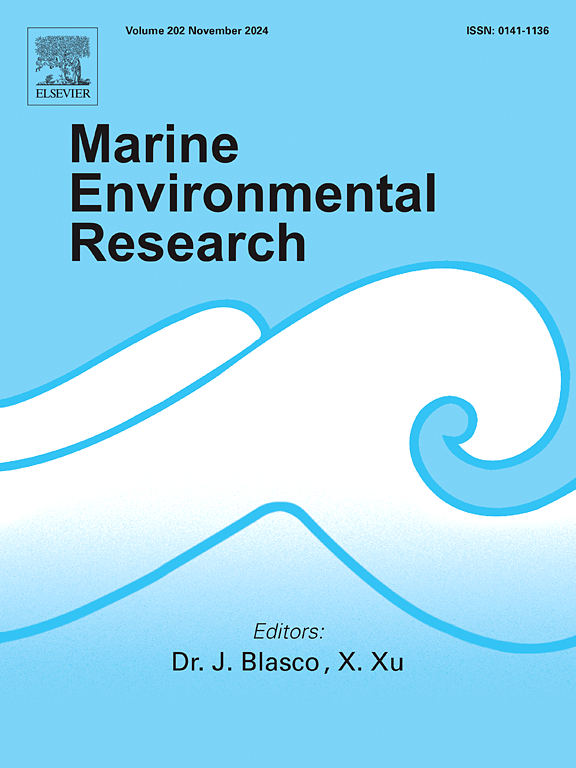亚硝酸盐胁迫对刺参代谢产物及基因表达的影响
IF 3
3区 环境科学与生态学
Q2 ENVIRONMENTAL SCIENCES
引用次数: 0
摘要
集约化养殖中亚硝酸盐的长期积累对海参(Apostichopus japonicus)的可持续性构成严重威胁。本研究通过转录组学和代谢组学分析,研究了日本刺参对21 d亚硝酸盐(4.88 mg/L)胁迫的分子和代谢反应。试验结束时,Cg组的增重率为11%,Nc组的增重率为- 9%。亚硝酸盐暴露对刺参生长性能有显著影响(p <;0.05)。代谢组学分析鉴定了36种不同的代谢物,揭示了TCA循环和氨基酸代谢的激活,以优先考虑能量产生和氮的再分配。转录组学数据突出了226个差异表达基因。值得注意的是,棘皮动物中TCA循环活性的关键调节因子Zimp10上调,而糖酵解相关基因FALDH下调,表明向节能有氧呼吸的转变。抗氧化能力通过抑制谷胱甘肽代谢基因(MGST1, GST)而受损,加剧氧化损伤。应激信号通路受到动态调控。下调Ras1-X2抑制mTOR活性,激活细胞自噬和有丝自噬进行细胞修复。此外,nod样受体通路的富集和vgtpase1样受体通路的上调标志着免疫参与。长时间的亚硝酸盐暴露破坏了适应机制,导致生理衰退。这些结果表明,日本刺参依赖于代谢重编程和应激信号来减轻亚硝酸盐的毒性,同时突出了抗氧化防御的脆弱性。该研究通过有针对性地管理亚硝酸盐暴露和代谢恢复策略,为优化水产养殖环境提供了重要见解。本文章由计算机程序翻译,如有差异,请以英文原文为准。
The effects of nitrite stress on metabolites and gene expression in sea Cucumbers (Apostichopus japonicus)
Chronic nitrite accumulation in intensive aquaculture poses a significant threat to the sustainability of sea cucumbers (Apostichopus japonicus), a key species in marine aquaculture. This study investigated the molecular and metabolic responses of A. japonicus to 21-day nitrite stress (4.88 mg/L) through transcriptomic and metabolomic analyses. At the end of the experiment, the weight gain rate of the Cg group was 11 %, while that of the Nc group was −9 %. Nitrite exposure significantly impaired growth performance of A. japonicus (p < 0.05).
Metabolomic profiling identified 36 differential metabolites, revealing activation of the TCA cycle and amino acid metabolism to prioritize energy production and nitrogen reallocation. Transcriptomic data highlighted 226 differentially expressed genes. Notably, Zimp10, a key regulator of TCA cycle activity in echinoderms, was upregulated, while FALDH, a glycolysis-related gene, was downregulated, indicating a shift toward energy-efficient aerobic respiration.
Antioxidant capacity was compromised through suppression of glutathione metabolism genes (MGST1, GST), exacerbating oxidative damage. Stress signaling pathways were dynamically regulated. Downregulation of Ras1-X2 suppressed mTOR activity, activating autophagy and mitophagy for cellular repair. Additionally, enrichment of NOD-like receptor pathways and upregulation of vGTPase1-like signaled immune engagement. Prolonged nitrite exposure overwhelmed adaptive mechanisms, leading to physiological decline.
These results demonstrate A. japonicus of reliance on metabolic reprogramming and stress signaling to mitigate nitrite toxicity, while highlighting vulnerabilities in antioxidant defenses. The study provides critical insights for optimizing aquaculture environments through targeted management of nitrite exposure and metabolic resilience strategies.
求助全文
通过发布文献求助,成功后即可免费获取论文全文。
去求助
来源期刊

Marine environmental research
环境科学-毒理学
CiteScore
5.90
自引率
3.00%
发文量
217
审稿时长
46 days
期刊介绍:
Marine Environmental Research publishes original research papers on chemical, physical, and biological interactions in the oceans and coastal waters. The journal serves as a forum for new information on biology, chemistry, and toxicology and syntheses that advance understanding of marine environmental processes.
Submission of multidisciplinary studies is encouraged. Studies that utilize experimental approaches to clarify the roles of anthropogenic and natural causes of changes in marine ecosystems are especially welcome, as are those studies that represent new developments of a theoretical or conceptual aspect of marine science. All papers published in this journal are reviewed by qualified peers prior to acceptance and publication. Examples of topics considered to be appropriate for the journal include, but are not limited to, the following:
– The extent, persistence, and consequences of change and the recovery from such change in natural marine systems
– The biochemical, physiological, and ecological consequences of contaminants to marine organisms and ecosystems
– The biogeochemistry of naturally occurring and anthropogenic substances
– Models that describe and predict the above processes
– Monitoring studies, to the extent that their results provide new information on functional processes
– Methodological papers describing improved quantitative techniques for the marine sciences.
 求助内容:
求助内容: 应助结果提醒方式:
应助结果提醒方式:


